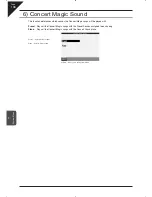
Page
117
7
System Men
u
15) MIDI Menu
The letters MIDI stand for Musical Instrument Digital Interface, an international standard for connecting MIDI
equipped synthesizers, drum machines, and other electronic instruments so that they can exchange data. Personal
computers can also be equipped for MIDI communication. Electronic instruments equipped with MIDI can transmit
and receive performance data such as, notes, what sound to play, pedal information, volume, etc. through the MIDI
In/Out/Thru Jacks. This data can be recorded with a device like a sequencer or a computer.
In this manual we will only discuss the basic MIDI functions that pertain directly to the CP. For detailed literature on MIDI,
please visit the music department of your local bookstore.
MIDI Settings
On page one of the MIDI Settings menu you can configure the following settings.
Right Transmit Channel
Sets the MIDI Transmit Channel for the RIGHT hand Parts. You can select MIDI Channels 1-16.
Left Transmit Channel
Sets the MIDI Transmit Channel for the LEFT/SPLIT Part. You can select MIDI Channels 1-16.
Chord Transmit Channel
Sets the MIDI Transmit channel the Chord data created by the Accompaniment System uses when it analyzes the
notes you play in the lower section of the keyboard. You can select MIDI Channels 1-16 and OFF. OFF disables
MIDI transmission of the chord data.
Chord Detect Channel
Sets the MIDI receive channel for chord data being sent to the CP. The Accompaniment System can be controlled
remotely on this MIDI channel by an external MIDI controller. You can select MIDI channels 1-16, OFF, All, or MIDI
Accordion. When set to ALL the Accompaniment System will respond to any chord data it receives on ANY MIDI
channel.
Local Control ON/OFF
This determines whether the CP’s sound will be played from the piano’s keyboard (“ON”) or only from an external
MIDI instrument (“OFF”). Even with local control “off” the CP’s keyboard will still transmit to an external MIDI
instrument or personal computer.
Clock
Clock is a data code that a MIDI instrument uses as the reference for its Tempo settings as well as Style Start/Stop
commands. When it is set to INTERNAL, the CP uses its own built-in clock to control tempo settings. When set to
EXTERNAL, the CP reads the clock data that it receives via MIDI and uses this data to control the Tempo.
¡
To configure the MIDI Settings:
Step 1
On page two in the System menu, touch MIDI.
The LCD screen will display the first MIDI page.
Step 2
Touch the screen to select settings, and the Dial to change values.
RIGHT TRANSMIT CH : Selects Transmit channel
for the RIGHT Part. Choose 1–16.
LEFT TRANSMIT CH : Selects Transmit channel
for the LEFT Part. Choose 1–16.
CHORD TRANSMIT CH : Selects Transmit channel
for the chord data. Choose 1-16 or OFF.
CHORD DETECT CH : Selects the chord detect
Receive channel. Choose 1–16, OFF, All,
or MIDI Accordion.
LOCAL CONTROL : Turns Local Control
on/off.
CLOCK : Selects the Clock source.
PAGE : Selects the other MIDI Settings pages.
Summary of Contents for Concert Performer CP139
Page 1: ...1 OVERVIEW OF CONTROLS 2 SOUNDS 3 STYLES 4 RECORDER 5 USB USAGE Quick Start Guide ...
Page 2: ......
Page 38: ...Page 38 USER NOTES ...
Page 39: ...Page 39 ...
Page 42: ...All descriptions and specifications in this manual are subject to change without notice ...
Page 217: ...Page 177 11 Appendices User Notes ...
Page 218: ......
Page 219: ......






























